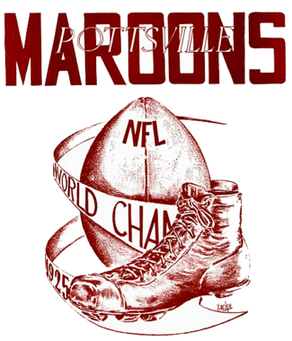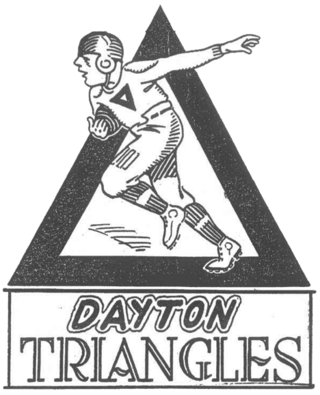
The Frankford Yellow Jackets were a professional American football team, part of the National Football League from 1924 to 1931, although its origin dates back to as early as 1899 with the Frankford Athletic Association. The Yellow Jackets won the NFL championship in 1926. The team played its home games from 1923 in Frankford Stadium in Frankford, a section in the northeastern part of Philadelphia, noted for the subway-elevated transit line that terminates there.

The Pottsville Maroons were an American football team based in Pottsville, Pennsylvania, in the northeastern part of the state. Founded in 1920, they played in the National Football League (NFL) from 1925 to 1928. In 1929 they relocated to Boston, where they played one season as the Boston Bulldogs.
The Columbus Panhandles were a professional American football team based in Columbus, Ohio. The club was founded in 1901 by workers at the Panhandle shops of the Pennsylvania Railroad. They were a part of the Ohio League from 1904 before folding after one season. Three years later, the team tried again, playing in the Ohio League from 1907 to 1919, not winning a championship, before becoming charter members of the American Professional Football Association (APFA) which became the National Football League (NFL).

The Dayton Triangles were an original franchise of the American Professional Football Association in 1920. The Triangles were based in Dayton, Ohio, and took their nickname from their home field, Triangle Park, which was located at the confluence of the Great Miami and Stillwater Rivers in north Dayton. They were the longest-lasting traveling team in the NFL (1920–1929), and the last such "road team" until the Dallas Texans in 1952, who, coincidentally, descended from the Dayton franchise.
The Evansville Crimson Giants were a professional American football team based in Evansville, Indiana and were a part of the National Football League in 1921 and 1922. The Giants home games were played at Bosse Field. According to the Evansville Courier and Press in 1921, 'they surprised local fans in developing a winning team' and 'the Giants' one-sided victories over inferior non-league teams has had good fan reaction.' However, the team did not succeed, mostly due to scheduling mistakes and management problems. Evansville's local sporting enthusiasts also failed to respond favorably and attend the home games.
Louisville, Kentucky had two professional American football teams in the National Football League: the Louisville Breckenridges from 1921 to 1924 and the Louisville Colonels in 1926.
The Kenosha Maroons were a National Football League football team in Kenosha, Wisconsin. Officially, the club only played in the league during the 1924 season, dissolving after posting no wins in five games.
The Milwaukee Badgers were a professional American football team, based in Milwaukee, Wisconsin, that played in the National Football League from 1922 to 1926. The team played its home games at Athletic Park, later known as Borchert Field, on Milwaukee's north side. The team was notable for having many African-American players for the time.
The Rochester Jeffersons from Rochester, New York played from 1898 to 1925, including play in the National Football League from 1920 to 1925.

The Rock Island Independents were a professional American football team, based in Rock Island, Illinois, from 1907 to 1926. The Independents were a founding National Football League franchise. They hosted what has been retrospectively designated the first National Football League game on September 26, 1920 at Douglas Park. The Independents were founded in 1907 by Demetrius Clements as an independent football club. Hence, the team was named the "Independents."
Throughout the years, a number of teams in the National Football League (NFL) have either moved or merged.

Wilbur Francis "Pete" Henry was an American football player, coach, and athletic administrator. He was a charter inductee into both the College Football Hall of Fame in 1951 and the Pro Football Hall of Fame in 1963.
The Cleveland Panthers were a professional American football team. They were an independent team founded in 1919 from the remains of the Youngstown Patricians. The Panthers played, with various degrees of success, continuously from 1919 and eventually, as fewer opponents played them each year after 1926, sputtered to a quiet folding in 1933.
The Ohio League was an informal and loose association of American football clubs active between 1902 and 1919 that competed for the Ohio Independent Championship (OIC). As the name implied, its teams were mostly based in Ohio. It is the direct predecessor to the modern National Football League (NFL).
The 1920 Cleveland Tigers season was the franchise's inaugural season in the American Professional Football Association (APFA) and fifth total as an American football team. The Tigers entered the season coming off a 5-win, 2-loss, 2-tie (5–2–2) record in 1919. After the 1919 season, several representatives from the Ohio League, a loose organization of professional football teams, wanted to form a new professional league; thus, the APFA was created.
Richard Vick was a professional American football player who spent three seasons in the National Football League (NFL) with the Kenosha Maroons, Detroit Panthers and the Canton Bulldogs.
Christopher O'Brien was a Chicago, Illinois house painter and plumber who became a pro football franchise owner. He is mostly known as the owner of the Chicago Cardinals, and has been called the "Father of Professional Football in Chicago". O'Brien was also a co-founder of the American Professional Football Association by representing the Cardinals at the September 17, 1920, league meeting at Ralph Hay's Hupmobile dealership in Canton, Ohio.
James Rothery Simpson was a blocking back in the National Football League. Simpson first played with the Toledo Maroons during the 1922 NFL season. The following season, he was a member of the St. Louis All-Stars, but did not see any playing time during a regular-season game. He played with the Kenosha Maroons during his final season after the Toledo Maroons made the move from Toledo, Ohio to Kenosha, Wisconsin.

The professional American football team now known as the Arizona Cardinals previously played in Chicago, Illinois, as the Chicago Cardinals from 1898 to 1959 before relocating to St. Louis, Missouri, for the 1960 through 1987 seasons.






